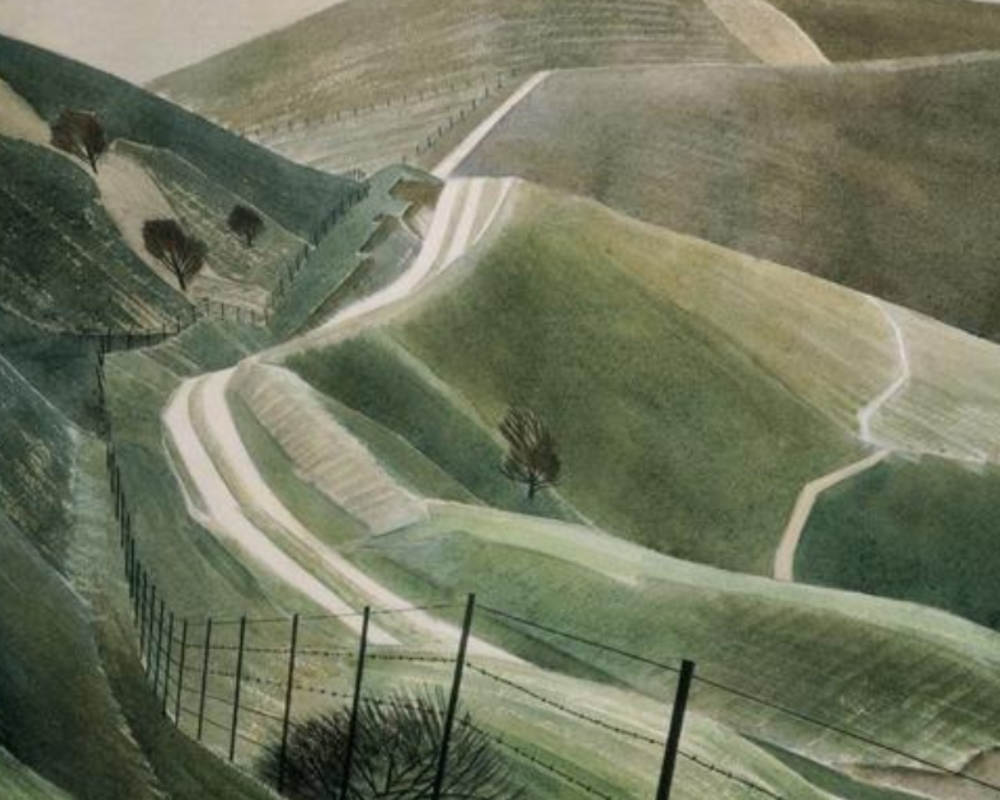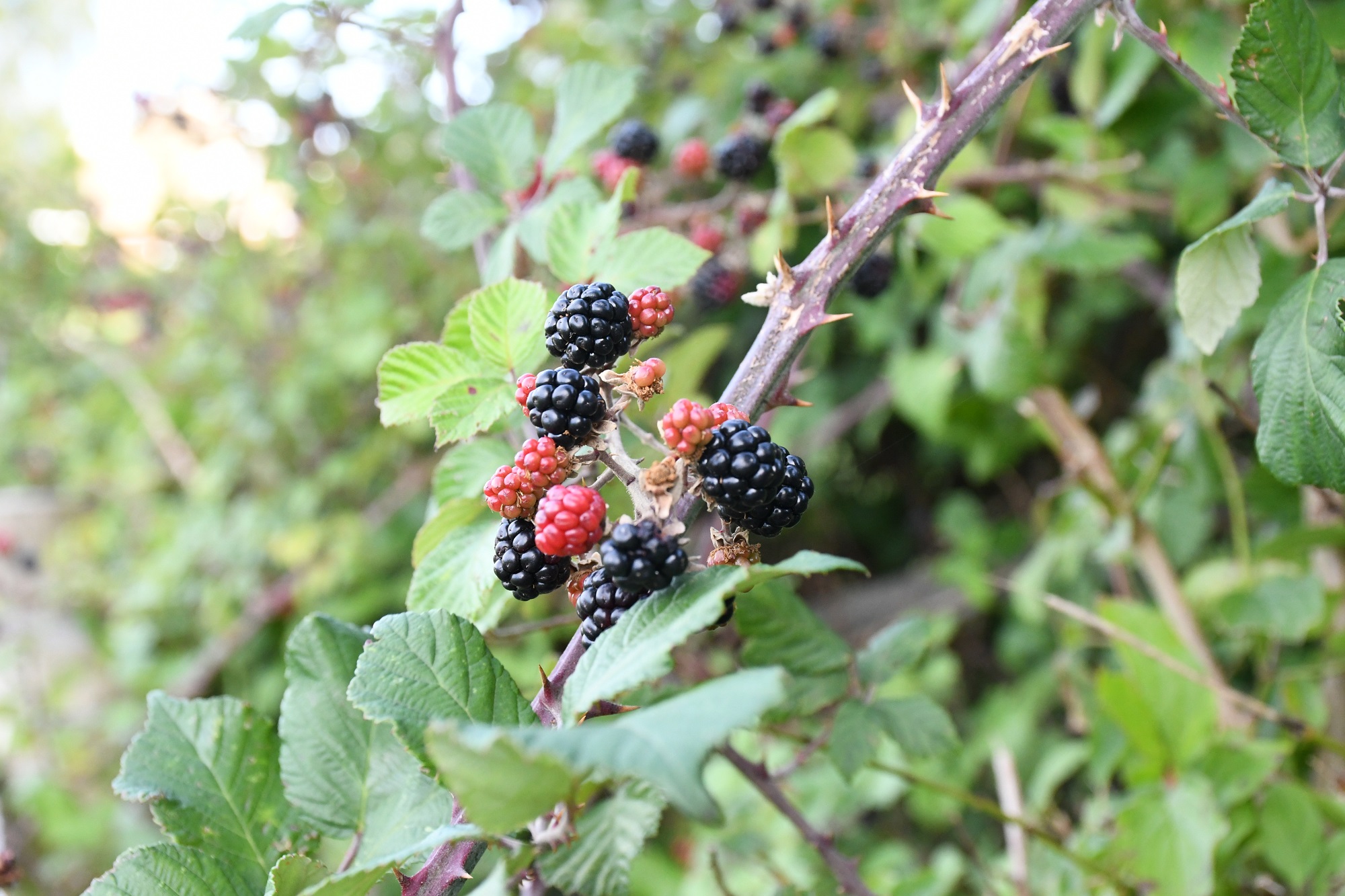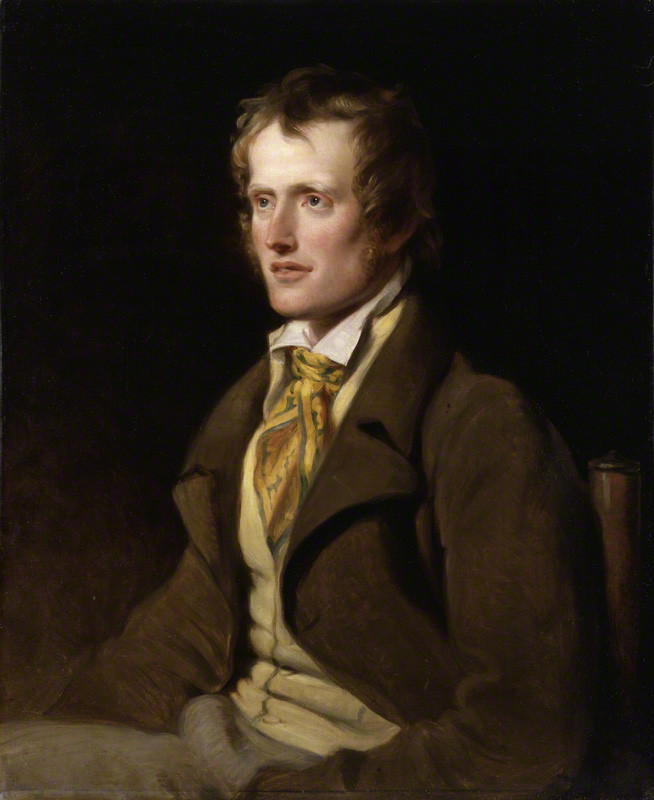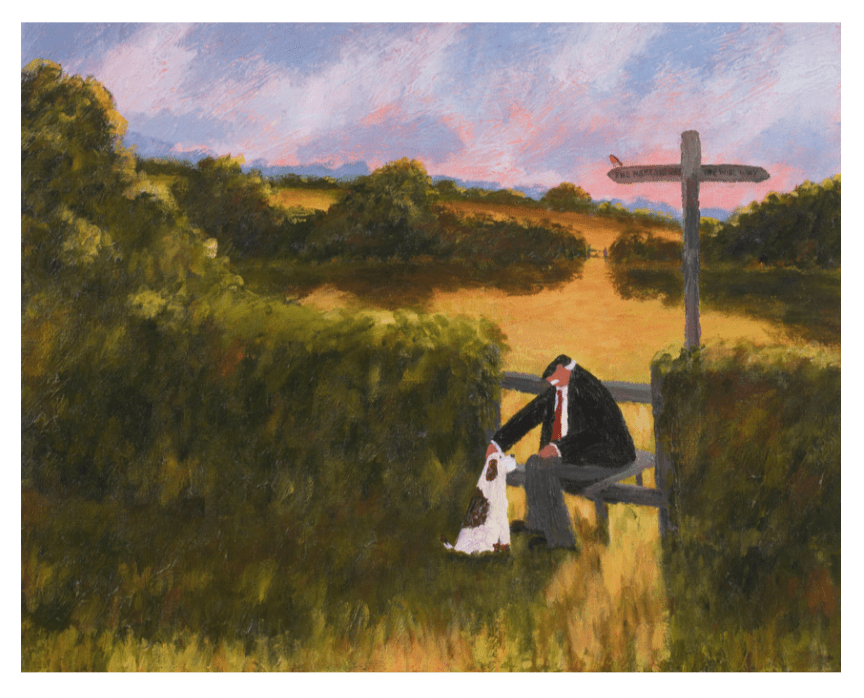"Just as the even bell rung we set out, to wander the fields and the meadows about and the first thing we markt that was lovly to view was the sun hung on nothing and bidding adieu."
When I spend a day talking, I feel exhausted; when I spend it walking, I am pleasantly tired." This simple truth from Thomas A. Clark's elegant prose poem captures the pristine benefits of walking: physical harmony, unity of mind and body, and lines delineated by movement through space and time. Walking is a way to see and root in one's environs or wrestle with inner thoughts. It is a way to set anchor in one's environment, wrestle with inner thoughts, or trade known space for the unknown.
Echoing what Thoreau called a pursuit of endless adventure, Clark continues: "Always, everywhere, people have walked, veining the earth with paths, visible and invisible, symmetrical and meandering."
 Chalk Paths, 1935 by Eric Ravilious.
Chalk Paths, 1935 by Eric Ravilious.
As we engage our gait, we invigorate our mind, argues Robert Macfarlane in his mapping the paths and trails we make and how they reciprocate by forming our inner landscape. Indeed, John Keats' surprisingly bright "Ode to Autumn" materialized in his sickly but invigorated mind-stuffs during many walks in Winchester.
Farm-labourer John Clare (July 13, 1793 - May 20, 1864), son of a thresher and the sole survivor of twins, was not, by any measure, a human destined by circumstance to become a brilliant poet of century-spanning substance. But throughout his life, a "pleasantly tired" aglow following ambles and sojourns was enough to summon the soul-heaving thoughtfulness of poetry. Clare's lush, longing perambulatory poems combine observation of nature at its minuscule universality with a broad horizon-wide view of humankind.
I love to wander at my idle will
In summer, luscious prime about the fields
And kneel when thirsty at the little rill
To sip the draught, its pebbly bottom yields
And where the maple bush, its fountain shields
To lie and rest a swailey hour away
And crop the swelling peascod from the land
Or mid the uplands woodland walks to stray
Where oaks for aye over their old shadows stand
Neath whose dark foliage with a welcome hand
I pluck the luscious strawberry ripe and red
As beautys lips and in my fancys dreams
As mid the velvet moss I musing tread
Feel life as lovely as her picture seems.
From "Careless Rambles"
 Photograph by Ellen Vrana.
Photograph by Ellen Vrana.The following poems (fraught with his grammatical invention) are a few of Clare's many walking - 'rambling'- poems inspired by movement, observation, and wistful longing.
Just as the even bell rung we set out
To wander the fields and the meadows about
And the first thing we markt that was lovly to view
Was the sun hung on nothing and bidding adieu
He seemd like a ball of pure gold in the west
In a cloud like a mountain blue dropping to rest
The clouds all around him were tingd wi his rays
And the trees at a distance seemd all on a blaze
Till lower and lower and sunk from our sight
And blue mist came creeping wi silence and night
The woodman then ceasd wi his hatchet to hack
And bent a way home wi his kid on his back
The mower too lapt up his scythe from our sight
And put on his jacket and bid us good night
The thresher once lumping we heard him no more
He left his barn dust and had shut up his door
The shepherd had told all his sheep in his pen
And hummed his song to his cottage agen
But the sweetest of all seeming music to me
Was the song of the clumbsy brown beetle and bee
The one was a hastning away to his hive
The other was just from his sleeping alive
And our hats he kept knocking as if hed no eyes
And when batterd down he was puzzld to rise
The little gay moth too was lovly to view
A dancing wis lily white wings in the dew
From "Recollections After an Evening Walk"
Please do not imagine that walking meant some level of escapism commonly associated with rural jaunts; it was not.
Clare's poetry was written on the heels of a massive country-wide change in England that redrew the fields and farms Clare knew as a child. The Enclosure Acts, passed in 1807 when Clare was 16, reduced non-profit generating common and waste lands by dividing and privatizing the space. Although footpath access remained, the land immediately beyond the paths - hitherto public - was no longer usable for foraging, grazing, or dumping rubbish. The Acts also dislodged the village as the hub of field, water, transport, and market systems. It would have been a vast logistical, financial, and psychological upheaval for any non-landowning family. The fabric of local life was sacrificed for economic efficiency and scale.
Themes of home, longing, memory, and nostalgia are blended throughout Clare's work:
When we stray far away from the pleasant old village
We love it the fonder, the further away
The sweet, melodic songs of ploughman owe their tillage
Are more pleasant sounds than the strange calls to day
That sweet little homestead with pollard ash and pong
Leads back a hundred miles wherever I may roam.
From "Recolections of Home"
To Clare, like many, the home was sweeter in memory than reality. The familiar landscape changed overnight with "No Trespassing" signs. As we imagine Clare walking about his beloved lands, remember that he is moving around a transformed space.
Often did I stop to gaze
On each spot once dear to me
Known among those rememberd days
Of banishd happy infancy
Often did I view the shade
Where once a nest my eyes did fill
And often markd the place I playd
At 'roley poley' down the hill.
From "Recolections After a Ramble"
Clare published his first set of poems, "Poems Descriptive of Rural Life and Scenery," in 1820 when he was 27. The set was introduced with the lines "genuine productions of a young Peasant, a day-laborer in husbandry, who has no advantages of education...". Clare became a bit of a spectacle when individuals who had read his poems wanted to meet him and thus separated him from the actual labor from which he earned a living.
This spirit of separation - even alienation - from land, people, and occupation is felt throughout his abundant verse. Although Clare is now memorialized in Poet's Corner in Westminster Abbey, a sacred space held for the most significant literary purveyors (some in body and others in spirit), Clare's work is still being parsed and understood along the lines of his contemporaries.
Partly and unfairly, that is due to his mental upheaval the last few decades of his life. Although, as early as 1820, Clare admitted to "low ebbs" and melancholy, it was not until 1837 that he revealed himself to an asylum on the outskirts of London. Although posthumous diagnosis can be highly inaccurate, Clare had what seemed like apoplectic fits, moments of depression and mania, and he faded in and out of coherence throughout his later adult life.
 "John Clare" by British portrait artist William Hilton. They were painted in 1820 when Clare was twenty-seven.
"John Clare" by British portrait artist William Hilton. They were painted in 1820 when Clare was twenty-seven.
Clare's diaries kept careful pace with his thoughts: incoherent and confused. In 1841 Clare absconded from the asylum and walked more than 80 miles home to visit his first love Mary Joyce, who had died a few years previously and to whom Clare was convinced he was married.
His notes read:
July 18, 1841 - Sunday
Felt very melancholly-went a walk on the forest in the afternoon-fell in with some gipseys one of whom offered to assist in my escape from the mad house by hideing me in his camp to which I almost agreed but told him I had no money to start with but if he would do so I would promise him fifty pounds and he agreed to do so before Saturday again but he did not seem so willing, so I said little about it-On on Friday I went Sunday I went and they were all gone an old wide-awake hat and an old straw bonnet of the plumb pudding sort was left behind—and I put the hat in my pocket thinking it might be usefull for another oppertunity as good luck would have it, it turned out to be.
Clare was soon readmitted to an asylum in Northampton where he died two decades later from a stroke. Clare continued to write up until his death, and although his mental facilities were wanned, his work did not deteriorate. It culminated in his most famous poem, "I Am," a mournful poetic capture of being and nothingness:
I am - yet what I am, non cares nor knows;
My friends forsake me like a memory lost: -
I am the self-consumer of my woes;-
They rise and vanish in oblivion's host,
Like shadows in love's frenzied stifled throes: - and yet I am, and live - like vapours lost
From John Clare's "I Am"
Meanwhile, the foot-trodden veins of the earth have continued to evolve and erode; in 2000, Parliament passed the Countryside and Right of Way Act (CROW) which allowed more open access to land, including the rights to forage small quantities of mushrooms and blackberries and other items of once-common property.
 "Many Miles" illustration by Gary Bunt from The Man Who Found God.
"Many Miles" illustration by Gary Bunt from The Man Who Found God.
Read more of Clare's emotionally tense poetry here, and supplement his work with Ted Hughes' summoning of place and experience as the fountainhead of poetic verse, Nan Shepard's love letter to the Scottish Highlands that took a lifetime to work and rework, and Rachel Carson's close observations of nature's regenerative magic which, in the tradition of Clare, celebrates the universal in the everyday.


